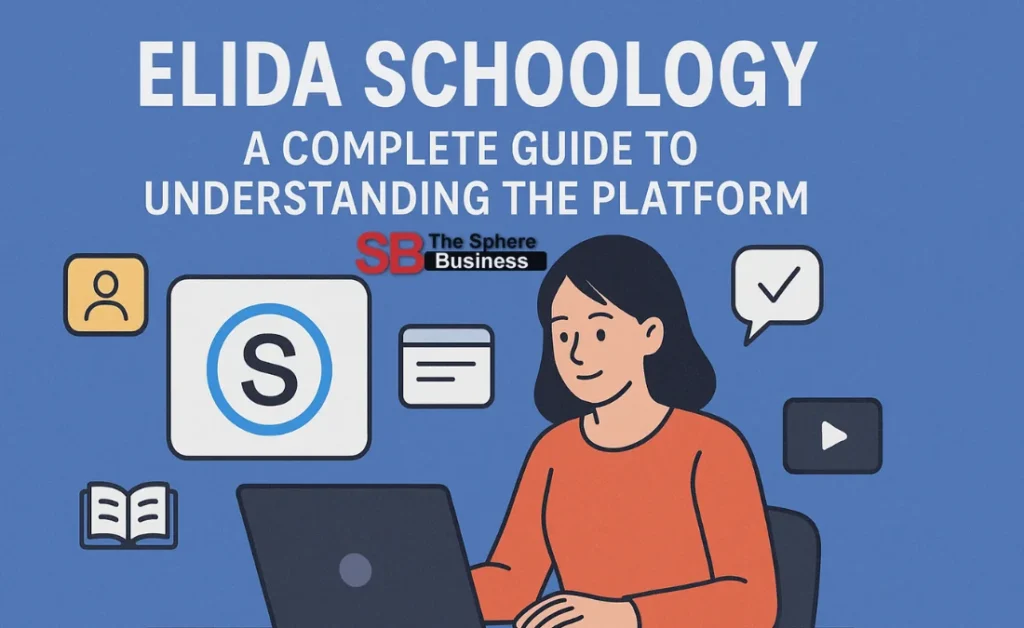Elida Schoology is the learning space many schools use to teach online. In this guide I explain Elida Schoology clearly and simply. Kids can follow and adults can help. You will read step-by-step tips and short classroom examples. I write plain advice for signing in, finding assignments, and getting feedback. I share teacher tips and parent notes to make work at home easier. This introduction shows experience and clear steps to build trust. Read on for simple, useful ideas you can try today. This helps with organization and reduces paper loss. Students learn better when materials are easy to find. Short videos and clear checklists help busy families. Using a consistent folder structure supports student success.
What is Elida Schoology? Elida Schoology is an online learning system.
It is a place where teachers post lessons and resources. Students open the lessons at school or at home. Teachers share assignments, quizzes, and useful files. Students upload work and get feedback from teachers. Parents can view progress and help when needed. The tool supports videos, quizzes, and discussion boards. It helps teachers and students stay organized and connected. Using a clear layout reduces confusion and saves class time. This helps with organization and reduces paper loss. Short videos and checklists are useful for busy families.
Why schools choose the platform
Schools choose the platform because it saves time and keeps learning organized. Teachers reuse lesson plans and share resources across grade teams. Students keep work in one online spot so papers do not get lost. Administrators like the reports that show which lessons help students most. Parents can see progress and missing work without guessing. The platform supports different learning types, such as videos, quizzes, and group projects. This structure helps teachers focus on teaching. Using clear folders and calendars reduces last-minute stress. Teachers can refine lessons over time with real class data. These routines support strong learning habits at home and school.
Key features you should know
Elida Schoology has many helpful parts. There are course pages and folders for files. Teachers make assignments and add rubrics for grading. A gradebook updates as teachers mark work. Students can upload files or type answers inside the site. There are private messages and group discussion boards. A calendar shows upcoming due dates and events. Some schools link the platform to cloud drives and video tools. These connections let students open files with one click. Short, clear rubrics help students know how to improve. Good naming and folders make grading faster and fairer.
Getting started: sign in and setup
To use Elida Schoology, sign in with your school account. Some districts use single sign-on for one-click access. Parents may get a special code to link their account. Choose a password you can remember but others cannot guess. Bookmark the sign-in page so it is easy to find. Explore notifications, courses, and the calendar slowly. Set a profile photo if the school allows it. These small steps help your year begin calmly and organized. This practice saves time, improves student organization, and makes home support simpler for parents. Students learn better when materials are easy to find.
Exploring the Elida Schoology dashboard
The dashboard is the first page you see after signing in. It shows your current courses, recent activity, and upcoming assignments. Course cards link to each class page where teachers place resources. A search box helps you find a post or file fast. Use the left menu to open the gradebook, calendar, and messages. If you have many courses, favorite the most used ones so they appear first. Set notification preferences to get only the alerts you need. Small steps like organizing your dashboard make each school day calmer. Short videos and clear checklists help families stay on track.
Creating, joining, and organizing courses
Teachers set up courses in Elida Schoology. They enroll students by roster or give a join code. To join a class, open Courses and choose Join Course. Enter the code your teacher shares in class. Teachers usually add a syllabus and a welcome note. Organize materials by weeks, units, or topics for clarity. Early joining helps students see due dates and expectations. A clear course layout makes learning easier for all. Using short lesson files and simple folder names helps busy students find work quickly. Good naming and folders make grading faster and fairer.
Assignments, grading, and useful feedback
Assignments in Elida Schoology show tasks, due dates, and sometimes rubrics that explain grading. Students upload files, attach links, or type answers inside the platform. Teachers grade and leave comments that guide improvement. When a grade surprises you, ask the teacher politely and check the rubric. Many teachers allow revisions, so use feedback to try again. Keep a backup copy of longer files, like essays or projects, so you never lose your work. Use clear file names like lastname_assignment.pdf for easy identification. Short feedback helps students learn and do better next time.
Communication tools: messages and discussions
Elida Schoology has private messages, group messages, and discussion boards. Use private messages to ask teachers short, private questions. Discussion boards let the whole class share ideas and answer prompts. Follow classroom rules online and use polite language when you post. Teachers may set rules for how often to post and how much to write. Parents can opt into email summaries to see recent activity. For group work, use messages to set meeting times and track decisions. Keep messages clear and focused. This habit helps teams work smoothly and finishes tasks on time.
Parent and student experience: different views
Students see course content, assignments, and received feedback. Parents usually link their account to view grades and missing work. Linking takes a parent code that the school provides. Once linked, parents can help with schedules, track progress, and message teachers. Students should keep ownership of their work. Parents should support but not do the tasks for the child. Talk about expectations together so students build responsibility. When parents and teachers communicate, students get steady support at home and at school. Short check-ins often make big differences for steady progress.
Teacher tips: how to make Elida Schoology work
Teachers can use simple habits to help students learn. Post a short weekly agenda at the start of each week. Label folders clearly by week or by topic. Give rubrics so students understand how work will be graded. Record short videos to explain hard tasks and post them. Offer quick help sessions for students who need extra time. Clear expectations and small routines help students stay on track. Use the calendar to set reminders for big projects. Small routines reduce misunderstandings and help learners stay confident. Teachers can reuse clear lessons to save planning time.

Security, privacy, and building trust
Privacy matters for any online tool. Use strong passwords and never share your login details. Schools set access rules so only the right people see grades. Teachers should show sources and explain where information comes from. Clear citations and steps show expertise and build trust. Parents can ask the school about district privacy policies. Open discussion about data use helps everyone feel safe. Check that third-party apps meet privacy rules before using them. Good safety habits keep student data secure and keep families confident in online learning.
Troubleshooting common problems
If the platform runs slow or a file will not upload, refresh the page first. Clear the browser cache or try another browser. Check file size and format if uploads fail. Rename files with a clear title like lastname_assignment.pdf. Try the mobile app if the desktop site acts up. Take screenshots of errors and send them to tech support. Keep local copies of important work so you can re-upload if needed. Many small fixes solve common problems quickly. Saving work often reduces stress and helps you finish tasks on time.
A simple classroom example
A teacher I know used Elida Schoology for a short unit about weather. She posted two short videos, a checklist, and a short quiz. Students used the discussion board to post one weather note each day. One student missed class, watched the video later, and posted answers online. The teacher gave a small participation grade and helpful comments on the quiz. The parent checked the gradebook and helped the student finish missing tasks. Clear posts and small steps helped everyone stay on track. This setup reduced stress for the whole family.
Integrations and helpful add-ons
Elida Schoology often connects to tools like Google Drive and Office apps. These links let students open files quickly and save work back to the course. Teachers can add apps for interactive quizzes or reading programs. Schools check privacy and compatibility before adding tools. Ask your teacher which apps they use and how to sign in. Learning a few linked tools makes turning in work faster and easier. Connections reduce friction when students move between documents, videos, and quizzes. Practicing the linked tools saves time during busy weeks.
Frequently Asked Questions
Here are six common questions about using Elida Schoology, followed by simple answers that help students and parents solve typical problems quickly. Each answer gives steps and tips to keep learning smooth. Read each Q and A carefully and try the steps at home. If a problem persists, reach out to your teacher or tech support with details and screenshots so they can help you faster. Short steps often fix most small issues and get you back to learning fast.
How do I reset my password for Elida Schoology?
If you forget your password, go to the district sign-in page and click the reset link. Some districts use single sign-on, so reset through the district portal. You may need your school email or student ID to reset. If the reset steps do not work, contact your school technology help desk. Give them your full name and class so they can verify your account and help reset access. Choose a password you can remember but others cannot guess. Write it down in a safe place if you need a reminder.
Can parents see my grades on Elida Schoology?
Parents see grades only when they link their account with a parent code from the school. Linked parents view assignment lists, grades, and teacher messages for their child. Schools protect privacy by sharing each student’s info only with their parent or guardian. If a parent needs access, contact the school office for the code. Talk with parents about how they will support homework while keeping the student responsible for completing tasks. Short, regular check-ins help students build independence and improve results.
What file types work best for uploading?
Common file types include PDF, DOCX, PPTX, JPG, and PNG. Check your school for size limits and preferred formats. For long videos, upload to a school-approved video service and paste the link in the assignment. If uploads fail, save as PDF or compress large files. Name files clearly with your name and the assignment title so teachers can find them quickly. Practicing good file habits avoids last-minute problems and helps teachers grade on time. Keep a local copy until the grade is posted.
How do I join a course using a code?
To join a course, open Courses and choose Join Course, then enter the join code your teacher gave you. Some schools auto-enroll students by roster so codes are not needed. If you do not have a code, message your teacher through the platform or ask during class. Joining early helps you see expectations and due dates before the term gets busy. Check the course welcome page and syllabus so you know the first assignment and class rules. Early planning reduces stress later in the term.
Is there a Schoology mobile app I can use?
Yes, there is a mobile app that shows assignments, messages, and course updates. Install it from your device’s app store and sign in with your school credentials. The app is handy for quick checks and notifications, but use a computer for long uploads and heavy editing. Keep the app updated and allow notifications if you want instant alerts about new posts and due dates. If the app acts up, close it and reopen, or reinstall after checking your internet connection. Short checks on the app keep you on track daily.
Who should I contact when something breaks?
Start by asking your teacher for help with course questions. For account or technical issues, contact your school’s IT help desk or technology coordinator. Many schools list tech support contact info on the district website. When reporting a problem, include your username, the steps you took, and a screenshot of the error. This helps tech staff fix issues faster. If many students are affected, the school may post system notices with updates. Clear reporting gets faster help and fewer delays for class work.
Conclusion and next steps
Elida Schoology can make school life easier when teachers, families, and students work together. Start by signing in often, checking the calendar, and organizing course folders. Teachers should post clear directions and quick feedback. Parents can link accounts to support learning at home without doing the work for students. Try one new tip this week, such as setting a calendar alert for an assignment or organizing a course folder. Small habits build confidence and reduce last-minute stress. Share this guide with your class or family if you found it helpful. Good routines help everyone learn better and enjoy school more.


